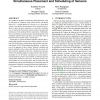Free Online Productivity Tools
i2Speak
i2Symbol
i2OCR
iTex2Img
iWeb2Print
iWeb2Shot
i2Type
iPdf2Split
iPdf2Merge
i2Bopomofo
i2Arabic
i2Style
i2Image
i2PDF
iLatex2Rtf
Sci2ools
IPSN
2009
Springer
2009
Springer
Simultaneous placement and scheduling of sensors
We consider the problem of monitoring spatial phenomena, such as road speeds on a highway, using wireless sensors with limited battery life. A central question is to decide where to locate these sensors to best predict the phenomenon at the unsensed locations. However, given the power constraints, we also need to determine when to selectively activate these sensors in order to maximize the performance while satisfying lifetime requirements. Traditionally, these two problems of sensor placement and scheduling have been considered separately from each other; one first decides where to place the sensors, and then when to activate them. In this paper, we present an efficient algorithm, ESPASS, that simultaneously optimizes the placement and the schedule. We prove that ESPASS provides a constant-factor approximation to the optimal solution of this NP-hard optimization problem. A salient feature of our approach is that it obtains “balanced” schedules that perform uniformly well over t...
| Added | 20 May 2010 |
| Updated | 20 May 2010 |
| Type | Conference |
| Year | 2009 |
| Where | IPSN |
| Authors | Andreas Krause, Ram Rajagopal, Anupam Gupta, Carlos Guestrin |
Comments (0)

